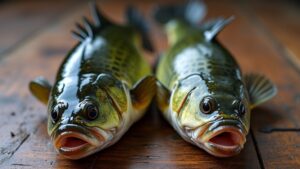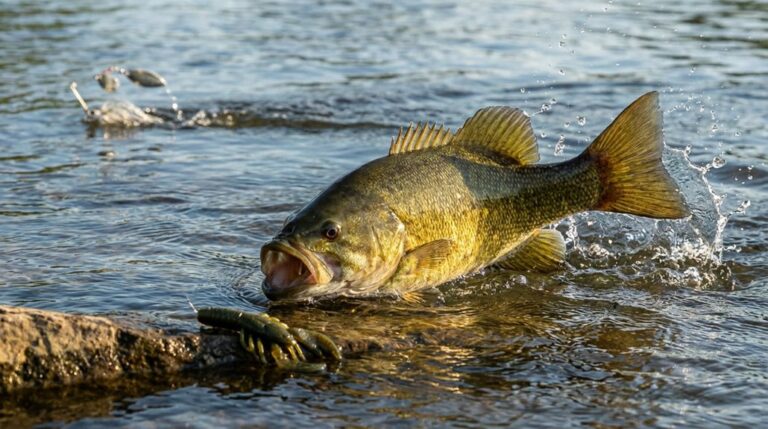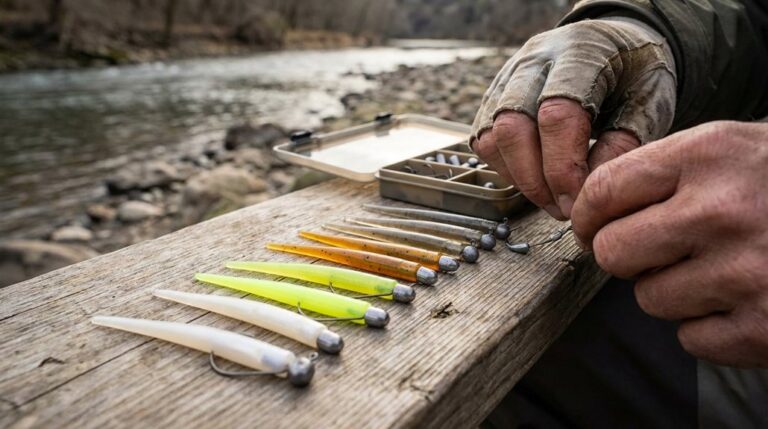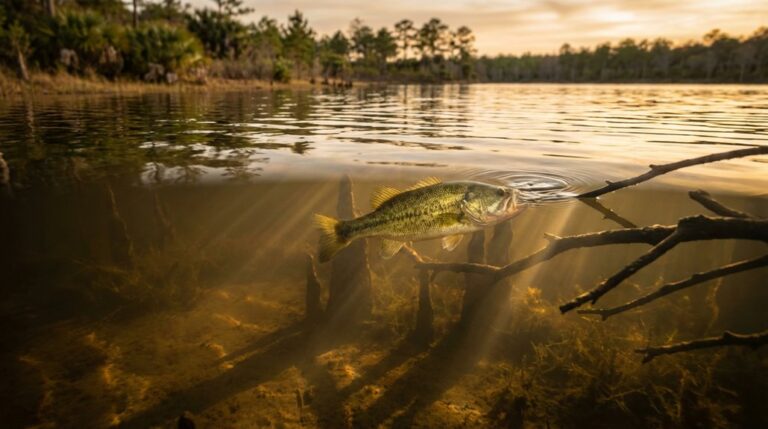“Black bass” refers to the Micropterus group of nine closely related species, while the largemouth bass (Micropterus salmoides) is one specific member. You’ll tell them apart by jaw length (largemouth’s upper jaw extends past the eye), a broad dark lateral stripe, and a preference for murky, weedy waters. Other black bass show spots, different scale counts, or clearer-water habits. You’ll also find hybrids and range overlap, and more ID tips follow if you want them.
Important Takeaways
- “Black bass” is a general group (Micropterus) that includes largemouth, smallmouth, spotted, and other species.
- Largemouth bass specifically have the upper jaw extending past the eye, a primary field ID trait.
- Largemouth show a continuous dark lateral stripe, while other black bass often have distinct blotches or spots.
- Habitat differs: largemouth prefer murky, vegetated shallows; other black bass favor clearer, rockier or deeper waters.
- Species ID can require scale counts or genetics due to hybrids and similar-looking Micropterus species.
What Defines “Black Bass” as a Group
What makes a “black bass” a black bass? You’re looking at fishes in the Micropterus genus—black bass are a sunfish group with nine recognized species whose taxonomy still sparks debate. You’ll use jaw placement as a quick field clue: largemouth bass’ upper jaw extends past the eye, while spotted bass and Alabama bass don’t. For finer differentiation you’ll check lateral line scale counts and blotch patterns—Alabama bass often shows 71+ scales and more uniform lateral blotches; spotted bass has fewer or smaller blotches and a distinct tongue tooth patch. Habitat, range, and hybridization further complicate species ID, so anglers and managers increasingly rely on genetic testing and zone-based rules to sort species and protect native stocks. Conservation concerns focus on habitat loss and hybridization threats for range-restricted species.
Largemouth Bass: Key Physical Traits
Ever wonder why anglers prize largemouth bass for both size and spectacle? You’ll notice the upper jaw extension that gives an impressive mouth size — it reaches past the eye, signaling a predator built for ambush. Their body coloration runs dark olive-green above, fading to a pale belly, and a bold dark lateral stripe streaks along the midline. You’ll spot distinct fin arrangement suited for explosive strikes and surface rolling. They favor murky, weedy shallows, explode on prey, and fight hard — size/weight can be enormous, with record specimens over 22 lb. Ear location? (not applicable) guides no ID here; visual cues win.
Proper cleaning and preparation demonstrate respect for the meal and help ensure the best possible taste.
| Feature | Impression |
|---|---|
| Jaw & mouth size | Ambush-ready |
| Color & stripe | Camouflage |
How Jaw and Mouth Shape Differentiate Species
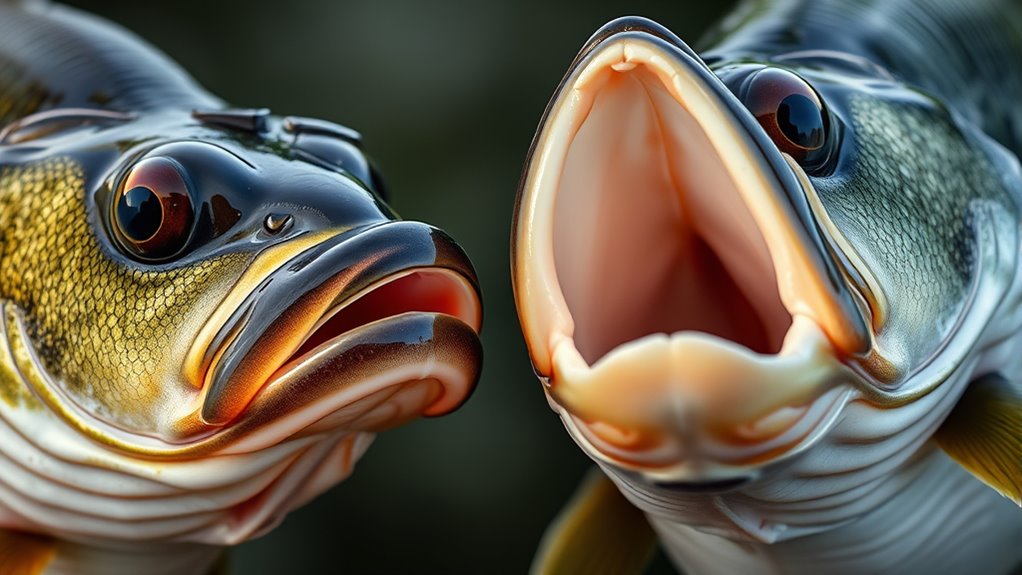
You’ve already noted the largemouth’s jaw extending past the eye — that single feature helps you separate it from several close relatives. When you check jaw length and mouth extension, the largemouth bass shows a distinct maxilla that projects beyond the eye, a clear jaw morph for species differentiation. The spotted bass and smallmouth bass both have a maxilla that reaches to, but not past, the eye, so their mouth is noticeably shorter. Florida bass often look like largemouths, but anglers rely more on scale counts and genetics than jaw position alone. Alabama bass resemble spotted bass in jaw form, so you’ll need combined traits to confirm identity instead of relying solely on mouth shape. For anglers determining species in the field, jaw length is one of several reliable morphological cues to check.
Coloration, Markings, and Lateral Patterns
Both species vary with habitat, their side patterns give you the quickest visual clue: largemouths carry a broad, dark lateral stripe running from the gill cover to the tail, whereas spotted bass show a series of distinct blotches or spots along the mid-side instead of a continuous band. You’ll notice pattern contrast immediately—largemouth body coloration often ranges green to olive with variable markings, while spotted bass lean green-brown with clear blotches. Check jaw extension and eye position too: largemouth maxilla extends past the eye, spotted bass’ jaw reaches the eye but not beyond, aiding ID. Dorsal fins can differ subtly, but the color pattern, side stripe versus spots, and midline blotches give you the fastest, most reliable field clues. Seasonal behavior and habitat (especially during spring spawning) can also influence coloration and make identification easier.
Typical Habitats and Water Preferences
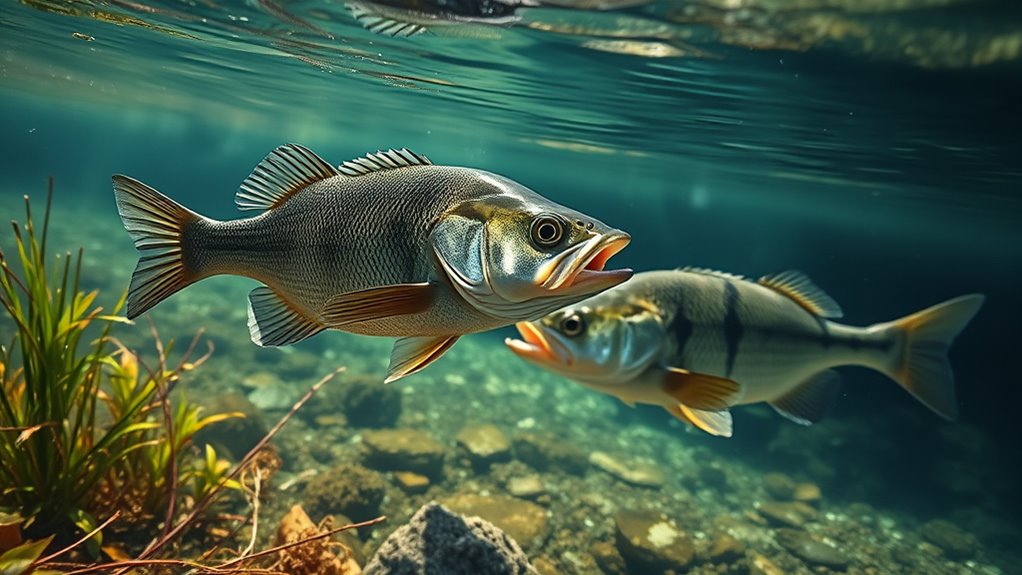
Where do these bass hang out most, and how does that affect how you fish for them? You’ll find Spotted bass in clearer water with rocky bottoms and vegetation cover, often suspending in deeper pockets of a reservoir or stream/river habitat. Largemouth bass prefer murky water and use weeds, brush, and logs to ambush prey, so you’ll fish shallower and bump cover.
| Spotted bass | Largemouth bass |
|---|---|
| Clear water, rocky bottoms | Murky water, heavy vegetation cover |
| Reservoirs, streams/rivers | Lakes, ponds, reservoirs |
| Suspend deeper, tolerate flow | Shallow to moderate depths, ambush predator |
| Example: Lake Lanier | Widespread across the U.S. |
Match lure depth and presentation to each species’ habitat preference for better strikes. A timber-rich environment like those found at timber-filled waters can change where and how you present baits.
Size, Growth, and World Record Comparisons
Curious which bass grows the biggest? You’ll find Micropterus salmoides leads the pack: largemouth bass size often hits a length range of 18–24 inches and can exceed 10 pounds in ideal waters, with Florida record weights reaching 22 pounds 4 ounces. In a straight growth comparison, smallmouth and spotted bass lag: smallmouth world records top near 11 pounds 15 ounces, while spotted bass usually average 12–17 inches and 1–2 pounds, though some lakes produce fish over 5 pounds.
Habitat impact drives these body size difference patterns—warmer, weed-filled, productive waters favor larger maximum weight for largemouth. For a clear bass species comparison, focus on habitat, prey availability, and record weights when judging growth potential. Largemouth bass have been widely introduced and are now established in many regions outside their native eastern North America, including 34 U.S. states and over 70 countries worldwide.
Hybridization, Range Overlap, and Identification Challenges
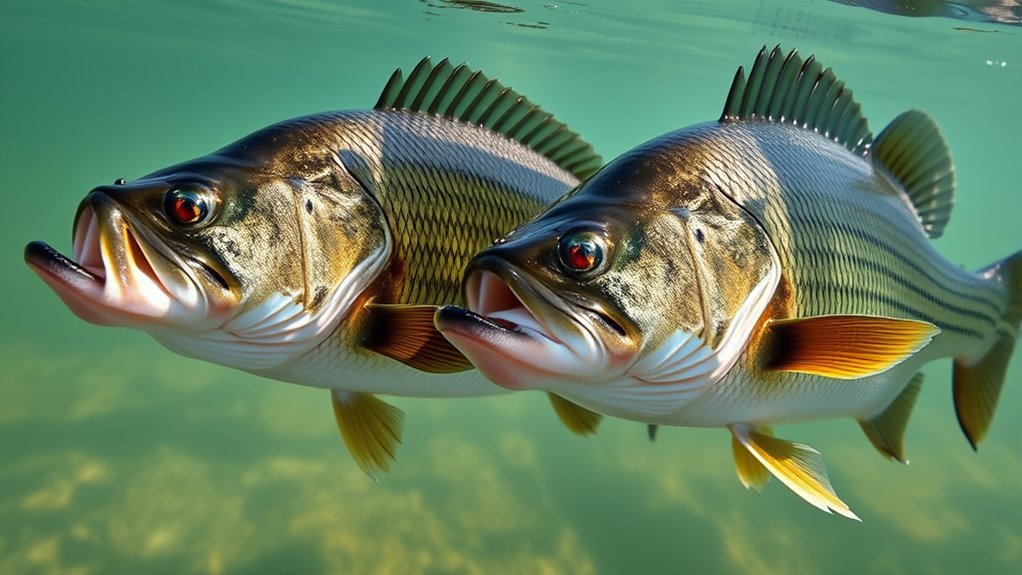
How do you tell closely related black bass apart when they share habitat and interbreed? You’ll face identification challenges where range overlap and hybridization blur features. Alabama bass and spotted bass often hybridize in the Mobile basin; count lateral-line scales—Alabama bass ≥71, spotted ≤70—to help. Florida bass is now treated as a distinct species (Micropterus floridanus), with lateral-line counts often >70 and larger size in warm waters, complicating IDs versus largemouth. Suwannee and redeye bass have regional traits in their native range that aid separation but still overlap locally. Trout frequently change streams seasonally due to shifts in water temperature and stream flow that alter habitat suitability and prey availability.
| Species group | Key note |
|---|---|
| Alabama vs Spotted | Hybridization common; lateral-line scales crucial |
| Florida/Micropterus | Distinct species; range overlap complicates ID |
Practical Identification Tips for Anglers
Want to tell a largemouth from a spotted bass quickly on the water? Check Largemouth jaw extension: if the upper jaw extends past the eye (eye margin vs maxilla), it’s a largemouth. Note the dark lateral stripe versus blotches vs stripe pattern — broad stripe points to largemouth, mid-side blotches to spotted. Use mouth size comparison and size range: largemouths are often larger (18–24 inches) than spotted (12–17 inches). Look at the dorsal fin notch: spotted bass usually show a deep notch between spiny and soft dorsal sections; largemouths have a continuous dorsal. Observe habitat (murky vs clear) and cover: weed beds vs rocky cover. Remember hybridization implications and local range when ID is uncertain.
Final Thoughts
When you’re identifying bass, remember that “black bass” is a group that includes several species, while the largemouth bass stands out with its extended jaw, bold lateral markings, and preference for weedy, slow waters. You’ll spot size and coloration differences, possible hybrids, and overlapping ranges that complicate ID. Trust jaw shape, mouth reach beyond the eye, and habitat clues first—those practical tips will help you tell largemouths from other black bass with more confidence on the water.

